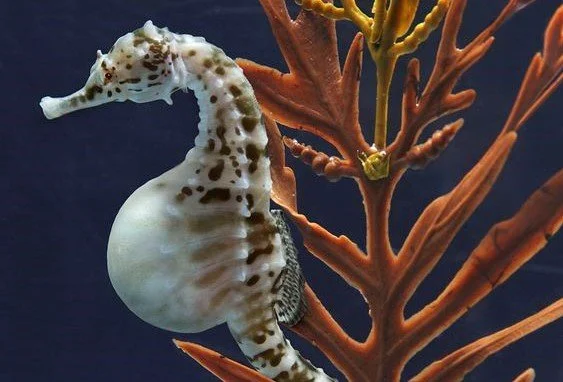Submerged in Wonder
I’ve been learning about the many emotional, physical, and spiritual benefits of experiencing moments of awe, so today I’m eager to share some awe-inspiring discoveries about seahorses—wondrous creatures that embody romance in unique and surprising ways. Not only do they defy conventional gender norms because the males gestate the offspring, seahorse couples also engage in enchanting multi-day courtship ritual dances before mating.
For three to five days, seahorse couples meet every morning right after sunrise to cement their bond and ensure synchronization for a successful pregnancy. They often greet one another by gently rubbing their noses together, and then they begin to circle each other, gracefully mirroring one another’s movements. They frequently change colors simultaneously, and often entwine their tails.
The final seahorse courtship dance can last for eight hours, and culminates with the female depositing her eggs in the male’s brood pouch. Once the male is in possession of the eggs, he fertilizes them with his sperm, and then supplies the embryos with the nutrients and oxygen they need through a network of capillaries in his pouch. Depending on the species, the male will carry anywhere between 50 to 2,000 eggs for 14 to 45 days.
Before birth, the offspring hatch from their eggs and swim around in the brood pouch, making the male’s stomach expand even more. When the time is right, he will give birth by contracting his stomach to expel the fully formed tiny seashores.
It turns out that male pregnancy gives seahorses a reproductive advantage. While the male is carrying the developing embryos, the female can prepare her next batch of eggs. Soon after the male gives birth, the female is able to transfer her eggs into his pouch, ensuring a nearly continuous cycle of reproduction. And here’s another surprising fact: Most seahorses are monogamous, forming lifelong bonds—an exceptionally rare trait among ocean animals.
I credit my four- and seven-year-old grandsons with igniting my rapidly growing fascination with the millions of incredible animal species that share our planet. Their boundless curiosity about the immense diversity of life on Earth constantly inspires research, wonder and awe.
Dr. Dacher Keltner, a leading psychologist and happiness expert at UC Berkeley, has found that the emotion of awe profoundly affects our well-being. Part of its magic is how it expands our view of the world, shifts our focus away from ourselves, and helps us feel more connected with one another. Awe also activates our parasympathetic nervous system, which calms stress, promotes relaxation, and even decreases inflammation and improves immune function.
In his book, Awe: The New Science of Everyday Wonder, Dr. Keltner writes, “It should not surprise that people who feel even five minutes a day of everyday awe are more curious about art, music, poetry, new scientific discoveries, philosophy, and questions about life and death. They feel more comfortable with mysteries, with that which cannot be explained.”
According to Dr. Keltner, two powerful ways to ignite awe are to observe the natural world and to experience or witness synchronicity (such as choreographed dance, a choir singing in harmony, or a sports team moving as one). So if you’re ready for a tiny dose of seahorse-inspired awe on Valentine’s Day, below are links to two very short clips: an 80-second video of a seahorse mating dance, and a 30-second video of a seahorse giving birth to more than a thousand babies.
As Abraham Joshua Heschel said, “Our goal should be to live life in radical amazement… get up in the morning and look at the world in a way that takes nothing for granted. Everything is phenomenal; everything is incredible; never treat life casually. To be spiritual is to be amazed.”





